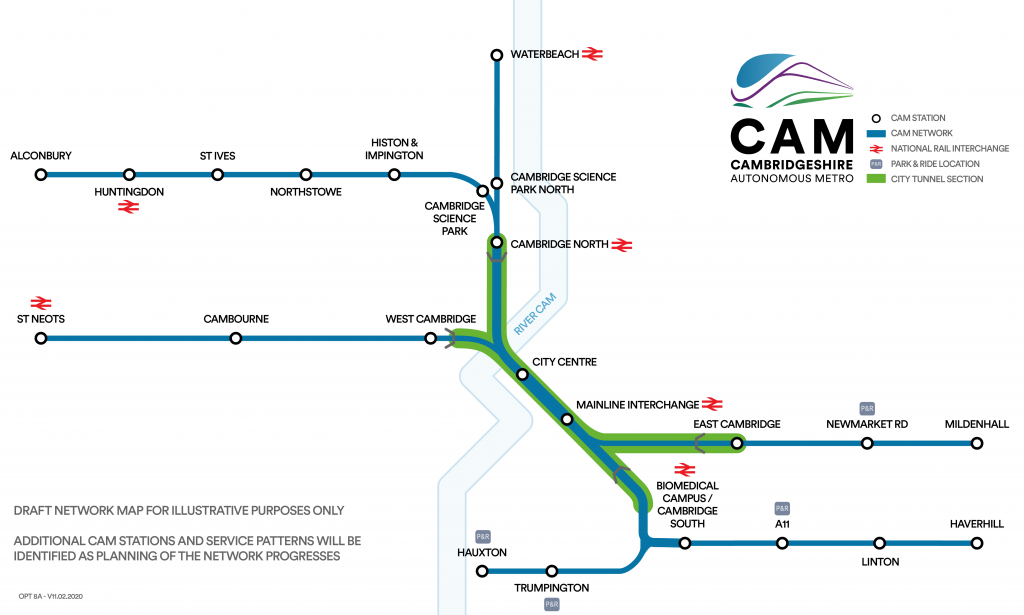
Three suppliers chosen to develop innovative concept designs to push forward pioneering CAM scheme
Three outstanding suppliers have been selected to develop bold, innovative conceptual designs to help inform and potentially transform the delivery of the Cambridgeshire Autonomous Metro (CAM).
The Cambridgeshire & Peterborough Combined Authority has challenged the best of the market to propose technologies, innovations, designs, operational systems and commercial ideas which could provide an in-the-round solution to the delivery of the CAM.
The procurement process for the designs launched in September 2020 and has resulted in three suppliers being awarded contracts to develop their concepts in full for presenting to the Mayoral Combined Authority in March.
The three designs will support the better understanding of how existing and emerging public transport modes, models and technologies could be applied to the CAM. The process will also encourage bold thinking which pushes boundaries, while remaining deliverable and offering value for money.
A series of staged reviews are planned with each supplier to ensure progress remains on track.
The successful suppliers are:
Dromos Technologies: Dromos Technologies develops Autonomous Network Transit (ANT) systems designed for medium to high-capacity urban passenger and freight traffic. Based in Munich, Dromos says it brings together the world’s leading autonomous driving, automotive and mass transit know-how to create the next paradigm shift in urban transportation. For the CAM designs, Dromos has partnered with UK designer PriestmanGoode and engineering firms Buro Happold and RLB.
Lars Herold, CEO of Dromos Technologies, said: “We are excited to develop designs for the Cambridgeshire autonomous transport system because it will become a lighthouse project showcasing how to solve passenger transport with 21st century technology.”
Egis: A major international group in the construction, engineering and mobility services sectors. The group brings together all of the skills in the field of urban transport including metro systems, light rail, autonomous public transport, and the development of associated stations and interchanges. Egis has developed projects internationally in cities ranging from small to medium size conurbations to megacities and from inception studies to commissioning. For the CAM designs, Egis will be supported by 10Design Architects and other industry leaders in the field of autonomous public transport.
Laurent Germain, CEO of Egis, said: “Egis is delighted to bring its vast expertise of designing unique public transport solutions for cities and regions of global significance. As a pioneer in metro automation, we have previously broken the mould and created some of the world’s most iconic metro systems. With the Cambridgeshire Autonomous Metro, we have another opportunity to transform the CPCA region’s future by introducing a sustainable solution that is bespoke, optimised and adaptable to emerging technological development that will stand out as a beacon for future autonomous systems to come”.
Mott MacDonald: A global engineering, management and development consultancy with a proud 45-year association with Cambridge. The company brings global capability in transport infrastructure, from involvement in London Underground, Crossrail and Sydney and Melbourne Metro systems, with development capability across the wider spectrum of urban rapid transit. Mott MacDonald has brought together a consortium of leading-edge companies MTR, Transport Design international, Maynard and Podaris, to support them.
Stephen Luke, Practice Leader Light Rapid Transit at Mott MacDonald, said: “Our team is delighted to have been selected to support the Cambridgeshire & Peterborough Combined Authority in developing solutions for the delivery of CAM. This truly is an ambitious and unique scheme requiring a careful balance of proven engineering, innovation and creativity.”
The conceptual design challenge is not intended to find the conclusive delivery solution for CAM, but will offer important input and challenge in the development of the programme and build interest among suppliers more widely who at some stage may want to bid on future phases of work.
Each supplier is also working with partners from a range of disciplines to develop the wide-ranging elements of the CAM solution required. The scope of the designs the suppliers will be expected to cover include:
The CAM vehicle: What type and size of proposed autonomous metro vehicles could be suitable, including considerations around guidance, operating systems and how it can be futureproofed against rapidly changing technology.
CAM infrastructure: What infrastructure the vehicle would run on, including the IT system and recommended approaches for their design, build, operation, safety assurance and maintenance.
Operations: How the CAM will run, and what the customer experience should be like.
Commercial relationships: Creative opportunities for revenue streams which will support the funding of the CAM.
The environment: Ensuring CAM is world leading in protecting the environment.
Mayor of Cambridgeshire and Peterborough, James Palmer, said: “The CAM will bring the world-leading, innovative and transformational public transport network that this region needs to continue to thrive.
“This challenge is a test to the very best brains in the market to help pioneer what the CAM will look like and how it can best be delivered. I’m clear that we want the CAM to offer our region the kind of high-quality public transport normally reserved for the biggest cities.
“We can be a trailblazer for the future of transport in a smaller cities and their regions and there is no better place in the world to be a first-mover than Cambridgeshire and Peterborough. Once again, we want this region to lead the way.
“The delivery of the conceptual designs in March will be another important milestone for CAM.”
- March’s Broad Street Improvements Shortlisted For National Transport Award
- Independent review set for bus franchising in Cambridgeshire and Peterborough
- Cambridgeshire County Council and Peterborough City Council Local Highway Maintenance Transparency Reports Released
- Publication of draft statement of accounts 2024-2025
- Mayor of Cambridgeshire and Peterborough Paul Bristow Statement: UK Industrial Strategy
- Combined Authority Market Towns Fund supports expansion of Huntingdon’s Cromwell Museum

